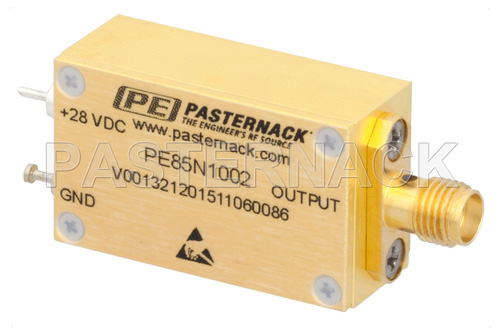 Random Electrical and thermal noise are natural phenomenon that is produced by every devices within a RF and microwave system. Depending on the severity of the noise, the introduction of a noise source in an RF system could reduce the signal integrity, bit-error rate (BER), overload a receiver, reduce the dynamic range, and otherwise degrade system performance. So, why would an RF system designer want to introduce noise into a system? For the purpose of designing a RF system resilient to noise, an RF engineer may use a calibrated RF noise source to better understand how sound propagates through an RF system and to provide a baseline understanding of the noise performance of RF devices.
Random Electrical and thermal noise are natural phenomenon that is produced by every devices within a RF and microwave system. Depending on the severity of the noise, the introduction of a noise source in an RF system could reduce the signal integrity, bit-error rate (BER), overload a receiver, reduce the dynamic range, and otherwise degrade system performance. So, why would an RF system designer want to introduce noise into a system? For the purpose of designing a RF system resilient to noise, an RF engineer may use a calibrated RF noise source to better understand how sound propagates through an RF system and to provide a baseline understanding of the noise performance of RF devices.
With known level of noise injected into a system, the sensitivity of the RF system to noise can be readily observed–which is a measurement known as noise figure. The determination of a component, device, or system noise figure enables comparison of RF performance. This process is often used with amplifiers, filters, switches, mixers, and other RF components and devices to determine the noise performance of each piece of an RF system. This way, the overall RF system noise performance can be predicted. It is important to note, that noise performance is often a function of frequency, power, temperature, and other phenomenon.
For these reasons, calibrated noise sources with the power level, broadband frequency performance, and interconnect capability are what distinguishes various noise sources for a particular application. The most common noise sources are inline-coaxial noise sources, but there are also bench top variable noise sources that allow for noise power level adjustment. Noise source modules that only provide an output noise are also available.
The performance of a noise source is measured as the excess noise ratio, which is the normalized measure of how much noise a source adds above thermal noise. The ENR of a noise source will likely vary over frequency, and this should be considered when evaluating a noise source. This is sometimes referred to as noise flatness, or simply flatness.
The quality of a noise source is also measured by its noise output temperature variation and noise output variation. Other factors to consider are the VSWR of an inline noise source, as this will also impact the signal passing through the device, as well as the impedance. As noise sources require external power, a bias voltage and input current may be carried along the coaxial transmission line, or powered through external connections.
Modern applications of noise sources also include the use of a traditional white Gaussian noise source as a jitter source. Such a source would be used to evaluate the performance of digitally modulated waveforms in high-speed communications application and bit-error rate performance. The compact nature of inline or terminal noise source modules enable them to be used in automated test equipment systems, or even built-in test equipment and diagnostic systems.




 Pasternack Blog
Pasternack Blog
